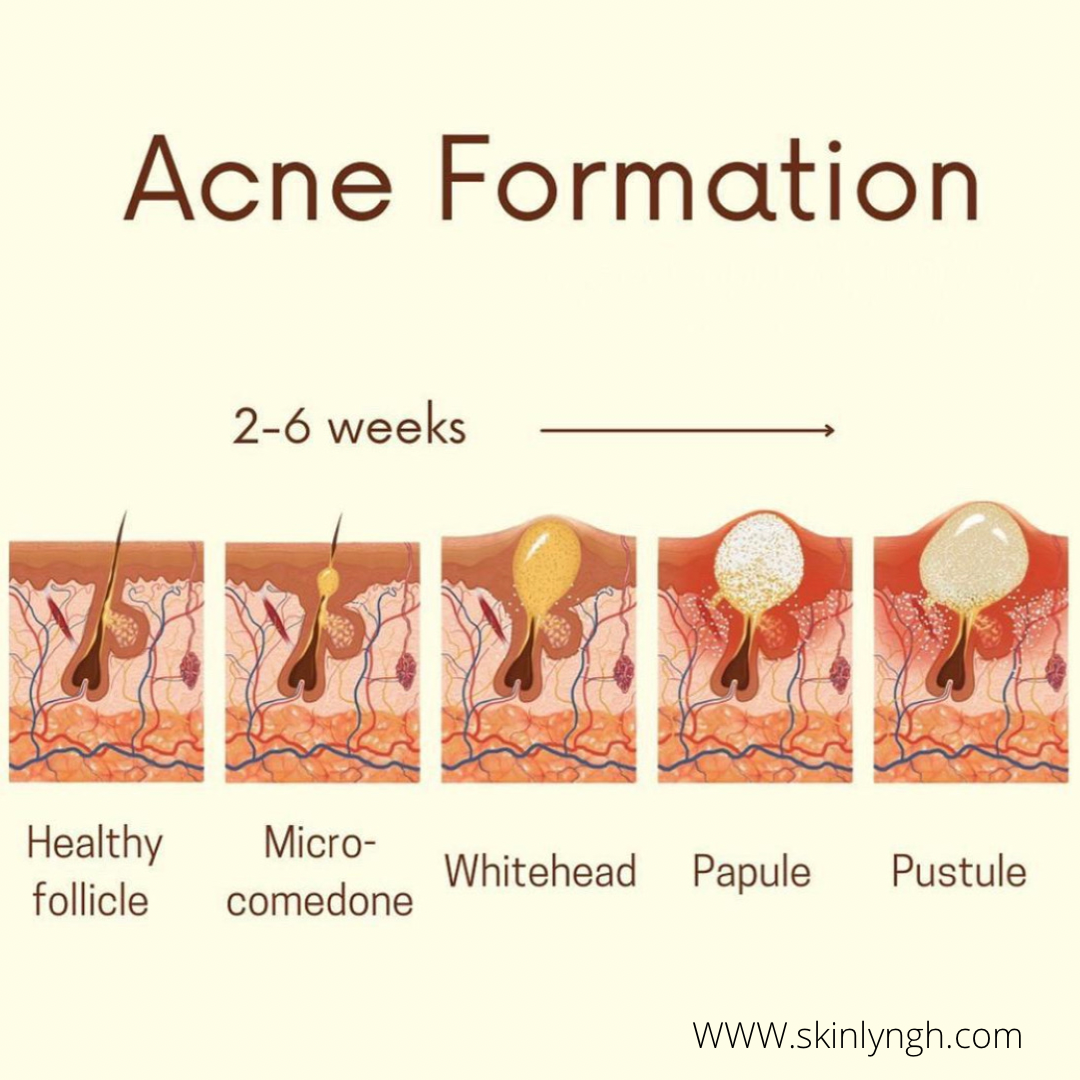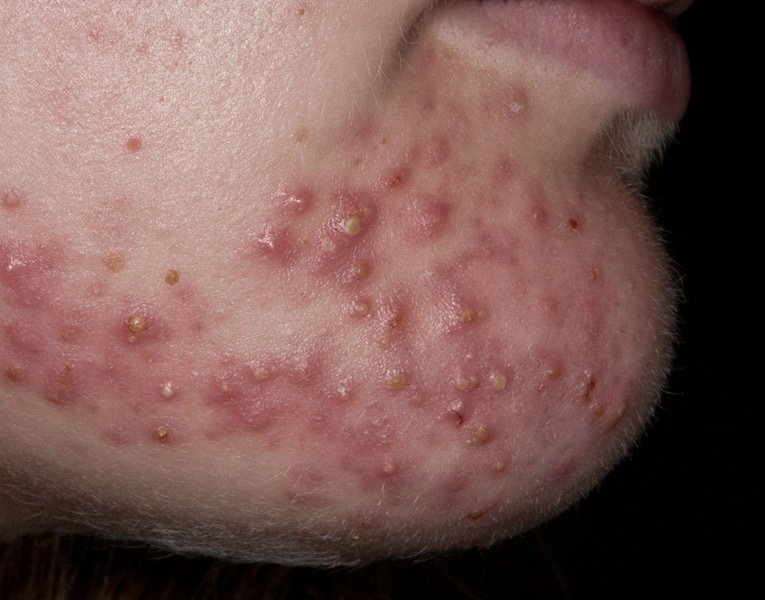Acne - Types, Causes and Treatment
Acne is a skin condition caused when hair follicles become clogged with oil and dead skin cells, causing whiteheads, blackheads, pimples, and large red tender bumps. Acne is most common among teenagers, though it affects people of all ages.
Acne Formation
Depending on its severity, acne can affect appearance, cause emotional distress, and scar the skin. The earlier you start treatment, the lower your risk of such problems.
Acne typically appears on your face, forehead, chest, upper back, and shoulders because these areas of skin have the most oil (sebaceous) glands.
Hair follicles are connected to oil glands.
Acne Causing Factors
Excess oil (sebum) production
Hair follicles clogged by oil and dead skin cells
Bacteria: The anaerobic bacterium called Propionibacterium acnes is a tiny microbe that lives in the oily region of the skin’s pores. The bacteria can aggravate an immune response which causes red, swollen bumps to develop on the skin (acne).
Inflammation: The body's immune system responds by combating the bacteria, which causes inflammation. This inflammation can lead to redness, swelling, irritation, pain, and itchiness, as well as blemishes.
Over-exfoliation: Over-exfoliated skin can become so vulnerable and damaged that it can be easily inflamed. This inflammation can then escalate into an acne breakout. Over-exfoliation strips the surface layer of the skin, taking away with it all the trapped.
Some cosmetics can cause acne: When this happens, you develop a type of acne called acne cosmetica. Even women who would not otherwise have acne can develop acne cosmetica from wearing makeup. Yes, you can wear makeup, but you'll want to choose it carefully. the overall impact of cosmetics on the development of acne lesions is considered to be negligible, since acne breakouts caused by makeup and other skincare products, known as acne cosmetica, typically resolve when patients stop using the pore-clogging product
Hormonal changes: Androgens are hormones that increase in boys and girls during puberty and cause the sebaceous glands to enlarge producing more sebum. Many women notice pimples get worse during their period due to hormonal changes during midlife. Many women experience breakouts due to hormonal changes. The spots may be small comedones or red and inflamed.
Certain medications: Examples include drugs containing corticosteroids, testosterone or lithium may cause result in acne breakouts
Diet: Studies indicate that consuming certain foods — including carbohydrate-rich foods, such as bread, bagels, and chips — may worsen acne. Further study is needed to examine whether people with acne would benefit from following specific dietary restrictions.
Stress: Stress does not cause acne, but if you are acne-prone or have acne, stress may make it worse.
Risk factors
Risk factors for acne include:
Age: People of all ages can get acne, but it's most common in teenagers.
Hormonal changes: Such changes are common during puberty or pregnancy.
Family history: Genetics plays a role in acne. If both of your parents had acne, you're likely to develop it too.
Greasy or oily substances: You may develop acne where your skin comes into contact with oil or oily lotions and cream with high comedogenic
Friction or pressure on your skin: This can be caused by items such as telephones, cellphones, helmets, tight collars, and backpacks.
Types of acne
Inflammatory acne, which includes cystic, nodule, pustule, and papule acne
Noninflammatory acne, which includes blackheads and whiteheads
CYSTIC ACNE
Cystic acne is one of the most severe types of acne and causes pea-sized or bigger pus-filled lumps to appear.
This type of acne can cause cyst-like lumps to appear.
Usually, the skin is very red and inflamed and the spots can leave severe scarring.
" You can get pea-sized or even larger lumps on the skin, "
" This can be associated with scarring and big cysts that are discharging pus and blood. "
NODULE
Nodular acne is characterized by hard, painful acne lesions deep under the skin. It often affects the face, chest, or back. Unlike regular pimples that often heal within a few days, acne nodules may last for weeks or months. They tend not to develop a white head and may remain as hard knots under the skin. Nodular acne is characterized by hard, painful acne lesions deep under the skin. It often affects the face, chest, or back. Unlike regular pimples that often heal within a few days, acne nodules may last for weeks or months. They tend not to develop a white head and may remain as hard knots under the skin.
PAPULE
Acne papule, also known as pimples or zits is a type of inflamed blemish that looks like a red bump on the skin. Papules form when there is a high break in the follicle wall. Papules don’t have a yellow or white center of pus. When a papule does accumulate pus, it becomes a pustule within a few days. These are often painful and result from an infection of the comedo by Propionibacterium acnes, a bacterial species which normally colonizes the skin. When numbers of papular spots are present, the acne may be classified as moderate or severe.
PUSTULES
Acne Pustules are small bumps on the skin that contain fluid or pus. They usually appear as white bumps surrounded by red skin. These bumps look very similar to pimples, but they can grow quite big.
Pustules may develop on any part of the body, but they most commonly form on the back, chest, and face. They may be found in clusters in the same area of the body.
Pustules may be a form of acne typically caused by hormonal imbalances or hormonal changes in the body allergic reaction to food, environmental allergies, or poisonous insect bites. This is a common skin condition, particularly among teenagers and young adults.
WHITEHEADS
These appear when pores become clogged with excess oil, bacteria, and dead skin cells. If the pore closes up, you’ll see a tiny bump that looks white or flesh-colored.
BLACKHEADS
may look like dirt stuck in pores. But actually, the pore is congested with bacteria and oil, which turns brown when exposed to the air.
Pimples are raised red spots with a white center that develop when blocked hair follicles become inflamed or infected with bacteria. Blockages and inflammation deep inside hair follicles produce cystlike lumps beneath the surface of your skin. Other pores in your skin, which are the openings of the sweat glands, aren't usually involved in acne.
Top Acne Treatments and Care
Wash your face twice a day (no more) with warm water and a mild soap made for acne-prone skin. Gently massage your face with circular motions. Too much washing and scrubbing can make the skin irritated. Dermatologists recommend applying an over-the-counter (no prescription needed) containing benzoyl peroxide after cleansing.
Don't pop or pick your pimples. It's tempting, but here's why you shouldn't: Popping pimples can push infected material further into the skin, leading to more swelling and redness, and even scarring.
Avoid touching your face with your fingers or leaning your face on objects that collect sebum and skin residue like your phone. Touching your face can spread the bacteria that cause pores to become inflamed and irritated. To keep bacteria at bay, wash your hands before applying anything to your face, such as treatment creams or makeup.
If you wear glasses or sunglasses, make sure you clean them often to keep oil from clogging the pores around your eyes and nose.
If have body acne try not to wear tight clothes. They don't let the skin breathe and may irritate it too. Scarves, headbands, and caps also can collect dirt and oil.
Take off your makeup before you go to sleep. When buying makeup, make sure you choose brands that say "noncomedogenic" or "non-acnegenic" on the label. Throw away old makeup that smells or looks different from when you first bought it.
Keep hair clean and out of your face to prevent dirt and oil from clogging your pores.
Protect your skin from the sun. It may seem like a tan hides acne, but it's only temporary. A tan may worsen your acne, not improve it. Tanning also causes damage to the skin that will eventually lead to wrinkles and increase your risk of skin cancer.
To unclog pores, dermatologists recommend using a retinoid. You can buy one retinoid, or over-the-counter products with benzoyl peroxide, salicylic acid, and niacinamide acne care products. Skinlyn Spot Treatment Gel helps dissolve the dead skin cells and oils clogging your pores and get rid of the excess acne-causing bacteria on your skin. Clay Treatment masks also can draw out excess oil and dirt thereby detoxifying and purifying your pores which keeps sebum production under control.
Give acne treatments six to eight weeks to work. If you still see blemishes, you may want to see an expert for A procedure like a comedo (medical term for blackheads and whiteheads) extraction may help.
NOTE: Give acne treatments six to eight weeks to work. If you still see blemishes, you may want to see an expert for a procedure like a comedo (the medical term for blackheads and whiteheads) extraction may help.
In our next blog on acne (Acne II) we will tackle types of acne, how they are formed, the skin types they are prone to and how to treat the different types of acne, and their Dos and Donts of acne care







